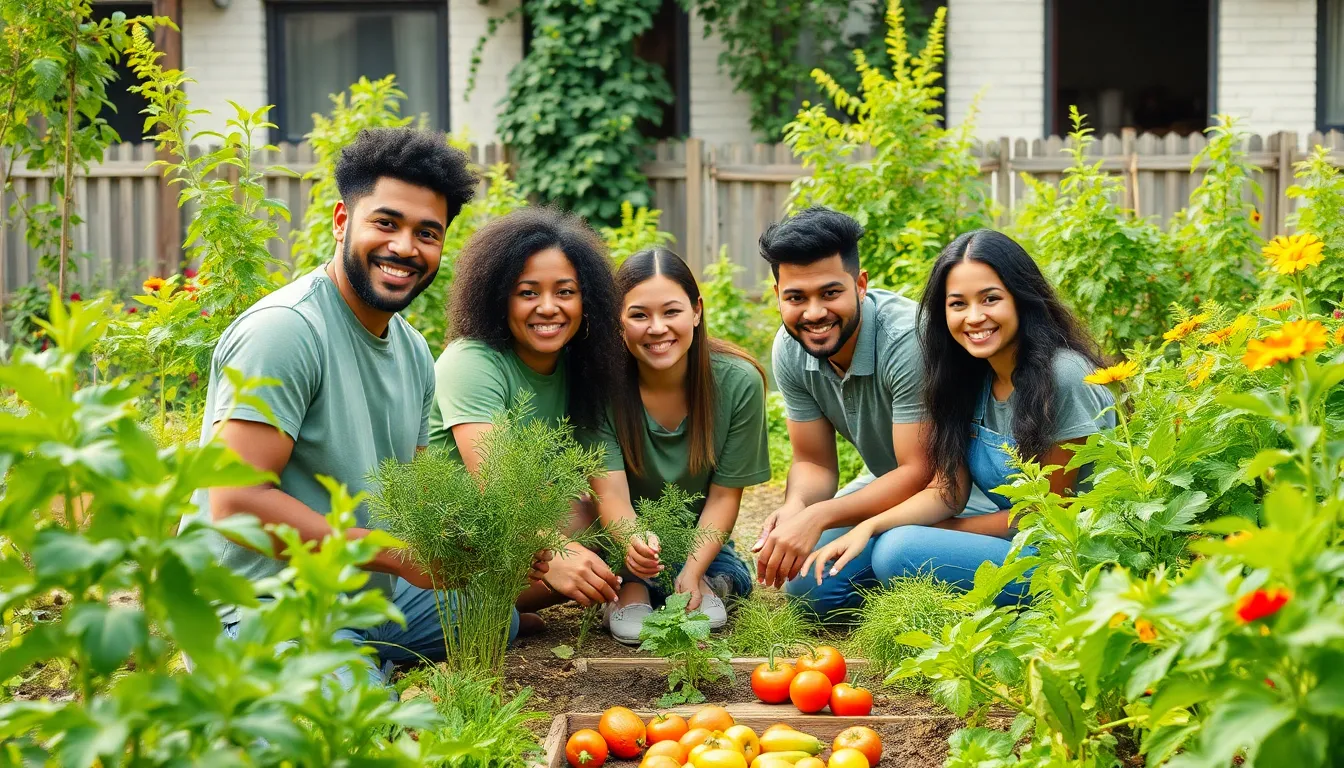In a world where eco-friendly choices can feel like a chore, embracing green living can actually be a breath of fresh air—literally! Imagine swapping out those plastic straws for reusable ones while feeling like a superhero saving the planet one sip at a time. Green living isn’t just about hugging trees; it’s about making simple, fun changes that add up to a bigger impact.
Table of Contents
ToggleWhat Are Green Living Ideas?
Green living ideas refer to various practices and choices aimed at reducing one’s environmental impact. These concepts promote sustainability and foster a healthier planet. Engaging in such ideas often begins with simple lifestyle adjustments, leading to a more eco-conscious way of living.
Using energy-efficient appliances represents one common practice. Energy-efficient models not only conserve electricity but also cut down on utility bills. Choosing public transport over personal vehicles can significantly lower carbon emissions as well. Adopting this practice not only helps the planet but also reduces traffic congestion.
Composting food scraps and yard waste offers another effective solution. Composting enriches soil and reduces landfill waste, promoting a circular economy. Urban gardening stands as a creative green living idea. Residents can grow herbs and vegetables in limited spaces, enhancing food security while minimizing the carbon footprint.
Incorporating reusable products into daily routines contributes to sustainable living. Items such as stainless steel water bottles, cloth shopping bags, and beeswax wraps help diminish single-use plastic. Furthermore, supporting local businesses and farmers markets strengthens community ties while encouraging eco-friendly practices.
Participating in community clean-up events can inspire others. These activities raise awareness about pollution and foster collective action. Exploring energy sources like solar and wind power also benefits green living. These options provide renewable energy alternatives, boosting overall sustainability.
Exploring these green living ideas collectively creates lasting change. Prioritizing sustainability manifests through daily choices, shaping a brighter future for the environment and future generations.
Benefits of Green Living

Green living offers numerous advantages, ranging from positive environmental effects to enhancing personal health.
Environmental Impact
Implementing eco-friendly practices significantly reduces carbon footprints. People who choose reusable products decrease waste in landfills. Maintaining energy-efficient appliances lowers electricity consumption, which helps protect natural resources. Supporting local businesses often results in reduced transportation emissions. Urban gardening not only promotes local food production but also enriches urban biodiversity. Communities that engage in clean-up events often see an improvement in local ecosystems. Adopting renewable energy sources like solar power enhances energy independence while benefiting the planet.
Personal Well-being
Embracing green living contributes to improved physical health. A diet rich in organic fruits and vegetables boosts nutrient intake and overall wellness. Spending time in green spaces has been linked to reduced stress and increased happiness. Additionally, engaging with local communities fosters social connections and can enhance mental health. The process of making conscious choices often leads to greater mindfulness and satisfaction. Eco-friendly habits encourage individuals to be more active, whether through walking instead of driving or gardening regularly. Ultimately, these lifestyle adjustments promote not just environmental sustainability but also personal fulfillment.
Practical Green Living Ideas
Green living can seamlessly integrate into daily routines. Here are actionable ideas that can make a significant difference.
Sustainable Home Practices
Energy-efficient appliances reduce electricity consumption effectively. Incorporating smart thermostats allows for better temperature control, optimizing energy usage. Using LED bulbs decreases lighting expenses while providing longer-lasting illumination. Homeowners can also reduce water waste by installing low-flow faucets. Choosing sustainable materials for home renovations enhances eco-friendliness and durability. Composting kitchen scraps transforms waste into nutrient-rich soil, benefiting gardens.
Eco-Friendly Transportation
Opting for public transport lowers individual carbon footprints considerably. Carpooling with friends or colleagues minimizes the number of vehicles on the road. Cycling not only promotes physical health but also eliminates emissions altogether. Walking for short distances offers an easy, healthy alternative that’s also environmentally friendly. Electric vehicles serve as a viable option, contributing to reduced pollution levels. Utilizing hybrid models combines traditional and alternative energy sources, decreasing overall impact.
Mindful Consumption
Purchasing locally grown food supports community businesses while cutting down transportation emissions. Prioritizing organic products ensures cleaner eating and promotes sustainable farming practices. Avoiding single-use plastics encourages a trend toward reusable options, conserving resources. Donations to thrift stores or resale shops extend the lifespan of items, minimizing waste. Choosing quality over quantity often leads to better long-term satisfaction and lower environmental effects. Practicing minimalism can promote a clutter-free lifestyle and align with eco-friendly principles.
Incorporating Green Living in Daily Life
Green living becomes part of daily life through simple, actionable steps. Small changes can create a significant impact when collectively practiced.
Small Changes That Make a Difference
Using reusable bags instead of single-use ones reduces plastic waste. Opting for water bottles that can be refilled helps cut down on disposable plastic. Choosing energy-efficient light bulbs lowers electricity consumption while saving money. Composting food scraps enriches soil and reduces landfill waste. Eating locally sourced, organic produce supports local farmers and decreases transportation emissions. Adjusting thermostat settings can enhance energy efficiency in homes, especially during extreme weather. Practicing mindful consumption leads to more thoughtful purchasing decisions.
Building a Supportive Community
Creating a supportive community fosters collective green living initiatives. Engaging neighbors in local clean-up events encourages shared responsibility for the environment. Forming or joining community gardens promotes urban gardening and food security. Organizing workshops on sustainability educates the public on eco-friendly practices. Supporting local businesses strengthens economic ties and reduces environmental footprints. Collaborating on recycling programs can enhance community waste management efforts. Sharing resources, like tools for gardening or carpooling, increases community cohesion.
Embracing green living is not just about making sacrifices; it’s about discovering joy in sustainable choices. Each small action contributes to a healthier planet and enhances personal well-being. By integrating eco-friendly practices into daily routines individuals can foster a more sustainable lifestyle that benefits both themselves and the environment.
The journey toward sustainability is filled with opportunities for creativity and community engagement. As more people adopt these practices the collective impact grows stronger. Ultimately, prioritizing green living leads to a brighter future for generations to come. It’s a rewarding path that encourages everyone to make a difference, one step at a time.






